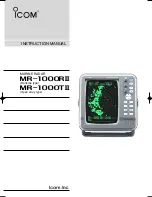
SeaTrac Serial Command Interface Reference
Page 14
Serial commands are provided to allow the user to mage changes to the working RAM settings
or read them back, and to save of load the RAM settings back into EEPROM as required.
However, like other memories of its type, the EEPROM memory has a lifetime endurance of
between 10,000 and 50,000 cycles, after which its data retention capabilities may start to
degrade (below the guaranteed 5 year period). For this reason, it is recommended that the
settings are only saved by to EEPROM following changes by the user, but not on an automated
periodic basis.
Some settings values can be automatically computed/changed as the beacon operates, such as
pressure-sensor offsets, velocity-of-sound and magnetic calibrations. When the beacon is
powered off, these changes will be lost unless specifically committed to EEPROM with a save
command. In practice though, on dynamic platforms it is often found that storing a default
calibration for the magnetometer is sufficient for start-up accuracy and the dynamic calibration
routine will further adjust the calibration as required by the magnetic environment. Values
such as pressure offset and VOS are computed within the first couple of seconds of operation.
Some settings, such as those controlling the communication hardware, are only applied on
power-up or a software reboot command. Details of these are discussed in section 6.4.9 on
page 57.
Settings can be reset to factory values by either issuing a Reset serial command, or using the
magnetically triggered reset-to-default sequence – for further details refer to the Beacons user
manual.
3.3.
Environmental Sensor System
Each beacon is fitted with an environmental pressure and temperature sensor that allow the
depth of each beacon to be calculated and monitored.
When used as part of a tracking system, the remote beacon’s depth information can be
transmitted and used as part of the position solution, improving vertical accuracy.
The pressure and temperature information can also be used to automatically update the local
velocity-of-sound value at each beacon, ensuring ranging calculations have the least possible
error.
Additionally, each beacon has a supply voltage monitoring circuit that can be used to provide
low-voltage alarms for battery powered systems. The data modem feature can be used to
optionally broadcast this information to other beacons on demand.
3.4.
Attitude & Heading Reference System
Each beacon is fitted with a 9 Degrees-of-Freedom (9-DOF) Attitude and Heading Reference
System, processing data from the onboard MEMS gyroscope, accelerometer and magnetometer
to compute pitch, roll and yaw information that is made available to external applications via
the communications port.















































